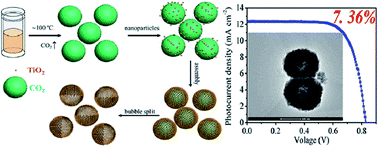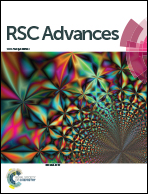Hierarchically porous N–F codoped TiO2 hollow spheres prepared via an in situ bubbling method for dye-sensitized solar cells
Abstract
Hierarchically porous N–F codoped TiO2 hollow spheres with a diameter of 0.8–1.8 μm and shell thickness of 250 nm are synthesized via an in situ bubbling method. Although the photoelectrode film constructed with the hierarchically porous N–F codoped TiO2 hollow spheres possesses a lower specific surface area than that of P25 nanocrystallites and thus achieves less dye adsorption, it may generate effective light scattering and therefore enhance the light harvesting efficiency, leading to higher power conversion efficiency (6.59%). The double layered DSSC with the hierarchically porous N–F codoped TiO2 hollow spheres as the top layer and P25 as the bottom layer is constructed and a 7.36% solar energy conversion efficiency is demonstrated, indicating a 10% improvement compared with the P25 cell of 6.65%. The improved photovoltaic performance of the double layered DSSC is primarily due to the effective suppression of the back reaction of the injected electron with the I3− in the electrolyte by decreasing the surface charge trap-site density of the photoanode and excellent light scattering ability.


 Please wait while we load your content...
Please wait while we load your content...